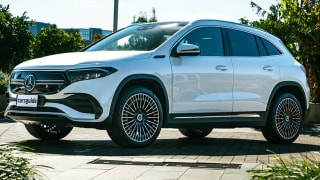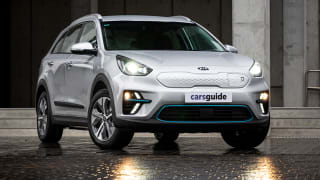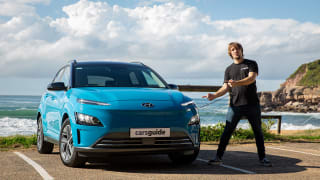There’s no question Volvo is continuing to present as a premium brand with this first electric offering. Despite dabbling its toes in the mainstream market in the past, the Swedish brand is only offering a fully bells-and-whistles approach to the XC40 this time around.
Wearing an MSRP of $76,990, the XC40 Recharge looks to specifically cross swords with the Mercedes-Benz EQA 250 ($76,800), but in reality, its rivals also include the Tesla Model 3 (Long Range $73,400), and all-new and much larger Hyundai Ioniq 5 (AWD - $75,900), both of which have big appeal to early EV adopters who may or may not be so fussy about brand.

This is interesting, because Volvo’s all-electric sister brand Polestar, which just launched in Australia, is offering its first car, the Polestar 2, with a far leaner price. This is clearly designed to take sales from not only its existentially threatening Tesla rival, but also mainstream players, like Nissan, with Polestar's base pricing set at $59,900.
It shares the same platform and much of the same technology as our XC40 Recharge , so if you’re turned off by this bells-and-whistles top-spec-only approach from Volvo, waiting a little longer will give you an intriguing and more affordable alternative.
Returning to the standard spec of the XC40 Recharge; it only comes with a single, large 78kWh battery pack and a dual-motor all-wheel drive system, offering twice the power of its nearest combustion version, a range between charges of 418km, 20-inch alloy wheels, a 9.0-inch portrait multimedia screen, dual-zone climate control, a panoramic opening sunroof, power adjustable front seats with memory, leather-accented interior trim, heated front seats with a heated steering wheel, ‘R-Design’ interior and exterior design highlights, ‘Thor’s Hammer’ LED headlights with cornering function, a Harmon Kardon audio system, 360-degree parking camera suite, tinted rear windows, and the full safety suite.
To clear things up, this means everything that can possibly be fitted in the XC40 range is standard on the Recharge electric version. You can even choose any of the eight exterior paint options at no extra cost.

Added to the standard equipment is a new version of the brand’s Android-based operating system, with an integrated SIM card and fully online Google services.
Not having any options helps this car regain some of the $10k price difference between it and the next model down (the PHEV version), but perhaps less on the $20k price difference between it and the conventionally powered T5 R-Design that sits below that.
Like the Mercedes-Benz EQA, it may also be a bit of a tall order for an EV which is naturally a bit compromised by sharing its platform with a combustion car. That might be enough for true EV enthusiasts to look right past this small SUV and onto the Tesla Model 3 or Hyundai Ioniq 5.




















